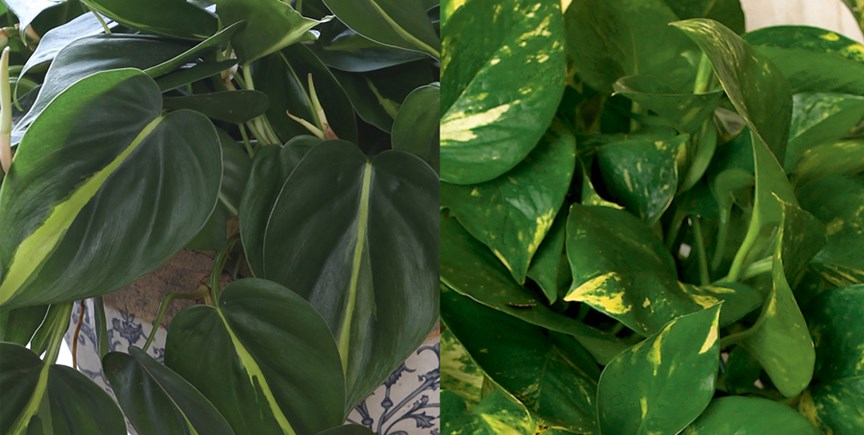The heart leaf philodendron flower is a beauty lasting for only two days. Each plant will have two or three flowers that bloom at different times during the blooming period. This is a great time to show off your heart leaf hanging plant.
Heart leaf philodendron are certainly some of the most important indoor house plants available although there are a few variegated heart leaf philodendron they are mostly green to reddish brown in colour. Some are majestic while others are content to creep along the ground. The genus name comes from the Greek words phileo meaning to love and dendron meaning a tree for its affinity to climb trees.
Light and Position
All heart philodendron require good positioning away from draughts and direct sunlight. Radiating plants need ample space around them and climbers need enough space above them to reach their full potential.
Temperature Range
These plants thrive best between 15-21 degrees centigrade (60-70 F) and suffer most when temperatures drop below 13 degrees centigrade (55F). The maximum summer temperature at which they are comfortable is 21 degrees centigrade (75F) and they will always enjoy a good mist-spraying.
Watering
Water directly onto the soil (with room temperature water, never straight from the tap) in the growing period and then allow the top layer to dry out before watering again. In the short midwinter rest period give them just enough to stop the soil drying out completely.
Feeding
The larger the plant and the longer it has been in the same pot, the stronger or more frequent feeds it will require. For smaller plants best results are obtained by including weak fertilizer in the water each time the soil is moistened. During Spring to Autumn feeding weekly is ideal and only once a month at most in the winter.
Seasonal Care
These are plants for all seasons but they should be kept out of very cold areas at all times. They have a short mid-winter rest period during which time they should have just enough water to prevent the soil from drying out. Water in moderation for the rest of the year while the plants are in active growth and new shoots are being formed.
Soil
Use a peat-based mixture with some loam and pot on only when the roots completely fill the pot. Many of the larger plants (in pots over 10in (25cm) in diameter) are best left where they are. Extremely large plants or those that will climb readily if tied to a stake should be started off in tubs. Brush off any loose soil around the roots and transfer to your prepared pot with a loose drainage layer. Press down firmly, water in well and don’t fertilize for the first two weeks.
All philodendron plant produce aerial roots of some kind from their stems, or trunks, which are used in their natural jungle habitat for entwining around tree trunks, so enabling them to climb. Bearing this in mind, it is important not to remove too many of these roots from the plants that are growing indoors. It is much better to tie them neatly to the main stem of the plant or its support and allow the top of the root to enter the soil when it is long enough. With the low growing, radiating types, any very long roots can be wound around the base of the plant on top of the soil, while smaller roots can be encouraged to enter the soil by making small holes with a pencil and inserting the root into it.
Pruning
Although they don't require a lot of pruning, occasionally cutting back philodendron plants keeps them looking their tropical best and keeps them from becoming too large for their setting. There are a few things to keep in mind; If you aren’t sure your plant needs pruning, wait. You can safely trim your philodendron at any time of year to remove yellowing leaves and trim spindly growth. Cutting back philodendron plants is beneficial if the plant is taking up too much space, or if the plant looks long and leggy. Do this in spring or autumn. Make sure you sterilise your tools first to prevent spread of disease-causing bacteria that may affect the health of your philodendron.
To sterile pruning tools, remove any mud or debris, then simply wash in a solution of nine parts household bleach to one part water. Bleach can damage your tools so rinse well in clean water after they’re sterilised.
Cut off the longest, oldest stems, or any stems that are leggy or have a lot of yellowing or dead leaves. In some cases, very old stems may be completely bare. Make cuts using a sharp, sterile knife, scissors or pruning shears, cutting where the stem meets the main part of the plant. If you can’t see where the base of the stem connects, cut the stem at soil level. If your philodendron is the vining type, use pruning shears or simply pinch the tips of vines to neaten up the plant and encourage bushier, healthier growth. Always cut or pinch growth just above a leaf node, which is the point on a stem where a new leaf or stem grows or you’ll be left with a lot of unsightly stubs.
Varieties
Philodendron Xanado also known as 'Winterbourne' is a large, compact, easy to grow plant. It is wider than it is tall reaching 2-4 ft high and 3-5 ft wide in ideal conditions. The leaves darken as it ages.
Philodendron Selloum (also known as Philodendron bipinnatifidum) is one of the best large house plants growing over 5 ft high with leaves spreading 2-3 ft. It does grow a trunk as it matures which the large drooping leaves hide. You can prune a Selloum with a sharp blade to control its size and shape, removing the lower stems if you want to see the trunk. Just remember to wash your hands and all equipment well afterwards. You wouldn't want to get the sap on your skin.
If you prefer a trailing or climbing plant the Philodendron scandens or Sweet Heart Leaf Philodendron plant is the one for you. The plant does particularly well in hanging baskets, where the trailing effects of its growth is most attractive. Pinch out some of the growing tips regularly to stop the plant straggling.
Pests and Diseases
FAQ's
Do Philodendrons need direct sunlight?
Philodendrons are native to the jungle of the West Indies and South and Central America. Because they thrive underneath the jungle canopy, they do well in low-light conditions.
Why are the leaves on my philodendron curling?
Curling leaves is an indication that they are getting too much light. Move them to a more shaded spot and the problem should reverse itself.
Do philodendrons grow fast?
In its native environment, philodendrons can quickly reach 15ft or more. Home cultivations sees this growth slow down somewhat. To optimise growth, keep the soil moist but not wet and in a bright but shaded spot that closely mimics the dappled jungle floor.
Is philodendron safe for dogs or cats?
This plant carries a low-severity poison warning, which means that it may cause severe oral pain if eaten so is best kept away from small children and pets. It is toxic when large amounts are ingested, and it may also cause contact dermatitis for those with allergic sensitivities.
Heart Leaf Philodendron vs Pothos
While they are similar in many ways and often confused with one another they are two different plants. Both are easy to care for requiring low light conditions and little watering. Pothos (right) tend to have larger, thicker leaves and stems then Philodendron (left) and are usually variegated. They are also hardier and grow faster. Philodendrons have cataphylls, (leaf sheaths) dark green leaves and is rarely variegated.

Source: http://www.costafarms.com
